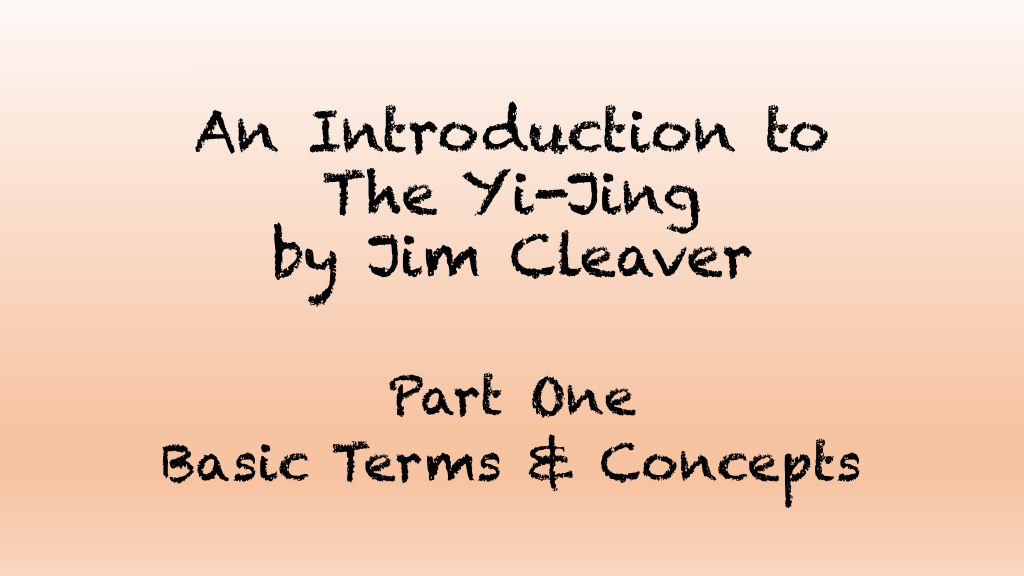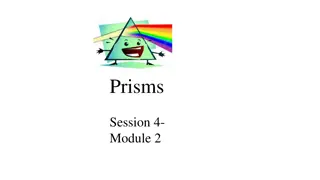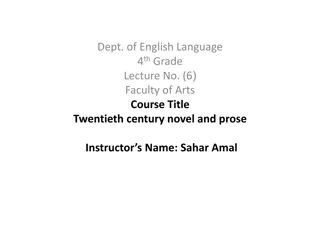The Yi Jing: Basic Concepts and Terminology
Explore the foundational concepts and terms of the Yi Jing, including the Chinese character "Yi" symbolizing change, pronunciation guides, Romanization systems, tones in Mandarin Chinese, and the significance of hexagrams in this ancient divination text.
Download Presentation

Please find below an Image/Link to download the presentation.
The content on the website is provided AS IS for your information and personal use only. It may not be sold, licensed, or shared on other websites without obtaining consent from the author.If you encounter any issues during the download, it is possible that the publisher has removed the file from their server.
You are allowed to download the files provided on this website for personal or commercial use, subject to the condition that they are used lawfully. All files are the property of their respective owners.
The content on the website is provided AS IS for your information and personal use only. It may not be sold, licensed, or shared on other websites without obtaining consent from the author.
E N D
Presentation Transcript
An Introduction to The Yi-Jing by Jim Cleaver Part One Basic Terms & Concepts
The Chinese Character Yi The Chinese Character Yi This character is a pictograph/ideogram Yi meaning change. How would you picture the concept of change? Some scholars suggest it is a picture of a lizard (think chameleon). Others say it is composed of the character for the sun above the character for the moon (turned sideways). I say both are good and make sense.
PRONUNCIATION PRONUNCIATION It is pronounced: which literally means: CHANGE (Y)EE JING CLASSIC (text, book, canon) (changes/changing) usually translated as: (characters can be interpreted as singular or plural) THE BOOK of CHANGE(s)
Spelling Chinese Sounds Spelling Chinese Sounds Pertinent to Yi Jing studies there are three relevant systems for Romanizing or transliterating Chinese sounds Pin-yin spells it YI-JING Pinyin is the current international standard for Romanizing Chinese and has been since 1976 This is the one I will use (though I will sometimes include the Wade too) Wade-Giles spells it I-CHING This system was developed in the late 1800 s by British linguists Thomas Wade and Lionel Giles (note, there is no apostrophe following the ch , therefore ch is to be pronounced like a j ) the old Missionary system spelled it YI-KING ( K is a southern dialect pronunciation)
Tones Tones Chinese is a Tonal Language Chinese is a Tonal Language Mandarin Chinese uses four tones to distinguish sounds that are otherwise homonyms. The same syllable pronounced using a different tone completely changes the word. Yi is pronounced using the 4th tone, which starts high and falls sharply. (yi in the 1st tone means to cure or heal, and hence, a doctor. It is a completely different character ) Jing is pronounced using the 1st tone, which is a high, even pitched tone. Pin-yin indicates the tone with marks over the vowel (the tone marks provide a visual clue to intonation) Y J NG Wade-Giles uses superscript numbers I4CHING1
Basic Terms Basic Terms Hexagrams, as their name implies, are graphic images comprised of 6 lines. There are 64 hexagrams
Each Hexagram is composed of two, 3 line symbols called Trigrams. There are 8 trigrams Collectively they are known as the Ba Gua (8 symbols) (In the Wade-Giles system this is spelled Pa Kua) pronounce like B and G as the pinyin spelling suggests not p and k as one might think looking at the Wade spelling (the W-G spelling often leads to mispronunciations)
Both trigrams and hexagrams are called gua = image/symbol They are differentiated by the addition of a number qualifier Thus liu-shi-si gua = 64 gua (means it s a hexa-gram) Whereas: ba gua = 8 gua (must be a tri-gram)
The individual Lines that compose both trigrams and hexagrams are of two types: one is a solid line the other is a divided line the solid line is called a yang line (also referred to as a firm, decisive, strong, or bright line) the divided line is called a yin line (also called a yielding, receptive, weak, or dark line)
The 8 Trigrams are all of the possible combinations of yin and yang lines in a three line figure. The 64 Hexagrams are all of the possible combinations of yin and yang lines in a six line figure. Thus these symbols constitute mathematically complete groups: yin & yang = 2 (by the way yin is pronounced yeen and yang is yahng) trigrams = 23= 8 hexagrams = 26= 64
Introducing the Trigrams I will present them in pairs Symbol Name Character Wade-Giles Pin-Yin Ch ien Qi n Natural Image The natural image is closely associated with the trigram and is smt. used as a substitute for its name 3 line graph Note: the WG and PY should be pronounced exactly the same, they are only spelled differently PY is usually closer visually (this is pronounced cheein) Heaven K un K n (this is pronounced kwun) Earth
Li L (this is pronounced lee) Fire K an K n (this is pronounced khan) Water (moving water) (darkness)(a pit)(danger)
Chen Zh n (this is pronounced Junn) Thunder Hsun/Sun X n /S n (this is pronounced Shun) Wind/breeze (wood)
Tui Du (this is pronounced Dway) Lake marsh/wetlands Ken G n (this is pronounced Gun) Mountain
Memorizing the Trigrams (Ba Memorizing the Trigrams (Ba Gua Gua) ) I strongly recommend memorizing these 3 aspects of trigrams: The graphic itself (there are only 8 and they are easily learned in pairs only 4 pairs) Its name (use the pinyin), but a good idea to recognize the WG too Its natural image
Guide to Memorizing the Graphics Guide to Memorizing the Graphics Notice that 4 trigrams are symmetrical: (Qian, Kun; Li and Kan) (turn them upside down and they stay the same) 4 are asymmetrical: (Zhen, Xun; Gen and Dui) (turn these upside down and they become their opposite) The secret beyond the first two: Qian (all 3 lines yang) & Kun (all 3 lines yin), is to notice where the single odd line is located: (with only 3 lines, two will always be of one type, leaving a solitary line of the other polarity) Note its location: is the solo Yin or Yang line in the lowest, middle or uppermost position or stated another way first, second or third position. (always count up from bottom) This will account for the other six trigrams.
Memorizing Graphs (continued) Memorizing Graphs (continued) Yin as the odd line: First/bottom Second/middle = Li/fire Third/top = Xun/gentle wind(breeze) = Dui/lake Yang as the odd line: First/bottom Second/middle = Kan/water Third/top = Zhen/thunder = Gen/mt.
























